selectBlockLocations
Select blocks from blocked images
Description
blset = selectBlockLocations(bims,Name=Value)
Examples
Create a blocked image.
bim = blockedImage("tumor_091R.tif");Create a block location set excluding incomplete blocks.
bls = selectBlockLocations(bim,ExcludeIncompleteBlocks=true);
Create a blockedImageDatastore from this set of blocks.
bimds = blockedImageDatastore(bim,BlockLocationSet=bls);
Visualize the block locations.
bigimageshow(bim) % Block size is in row-col (height-width) order. blockedWH = fliplr(bls.BlockSize(1,1:2)); for ind = 1:size(bls.BlockOrigin,1) % BlockOrigin is already in x,y order. drawrectangle(Position=[bls.BlockOrigin(ind,1:2) blockedWH]); end
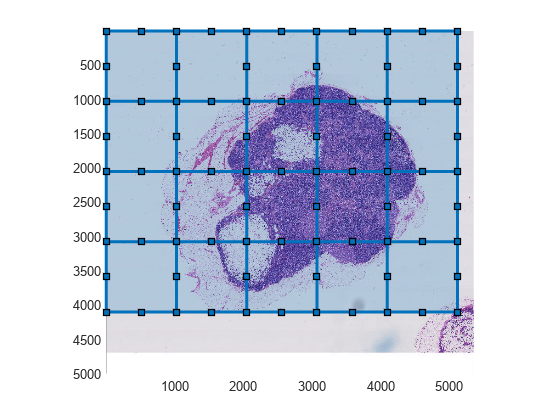
Create a blocked image.
bim = blockedImage("tumor_091R.tif");Create a blockLocationSet object.
blockSize = [2048 3072];
overlapPct = 0.5;
blockOffsets = round(blockSize.*overlapPct);
bls = selectBlockLocations(bim,BlockSize=blockSize, ...
BlockOffSets=blockOffsets,ExcludeIncompleteBlocks=true);Create a blockedImageDatastore from this set of blocks.
bimds = blockedImageDatastore(bim,BlockLocationSet=bls);
Visualize the blocked locations.
bigimageshow(bim) % Block size is in row-col (height-width) order blockedWH = fliplr(bls.BlockSize(1,1:2)); colors = prism(size(bls.BlockOrigin,1)); for ind = 1:size(bls.BlockOrigin,1) blockedColor = colors(ind,:); % BlockOrigin is already in x-y order drawrectangle(Position=[bls.BlockOrigin(ind,1:2) blockedWH], ... Color=blockedColor); end

Create a blocked image.
bim = blockedImage("tumor_091R.tif");Create a blockLocationSet object.
blockedSize = [1024 512];
spacePct = 0.5;
blockedOffsets = blockedSize + blockedSize.*spacePct;
bls = selectBlockLocations(bim,BlockSize=blockedSize, ...
BlockOffSets=blockedOffsets,ExcludeIncompleteBlocks=true);Create a blockedImageDatastore object from this set of blocks.
bimds = blockedImageDatastore(bim,BlockLocationSet=bls);
Visualize the block locations.
bigimageshow(bim) % Block size is in row-col (height-width) order blockedWH = fliplr(bls.BlockSize(1,1:2)); for ind = 1:size(bls.BlockOrigin,1) % BlockOrigin is already in x-y order drawrectangle(Position=[bls.BlockOrigin(ind,1:2) blockedWH]); end
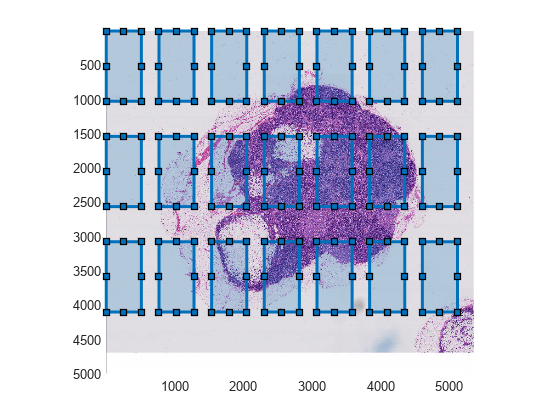
Create a blocked image.
bim = blockedImage("tumor_091R.tif");Display the blocked image.
h = bigimageshow(bim);
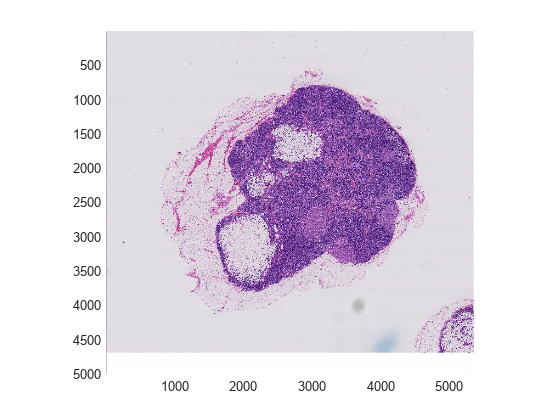
Create a mask at the coarsest level.
clevel = bim.NumLevels; bmask = apply(bim,@(b)~imbinarize(im2gray(b.Data)),Level=clevel);
Use showMask to estimate an InclusionThreshold value.
showmask(h,bmask,BlockSize=[256 256],InclusionThreshold=0.9)
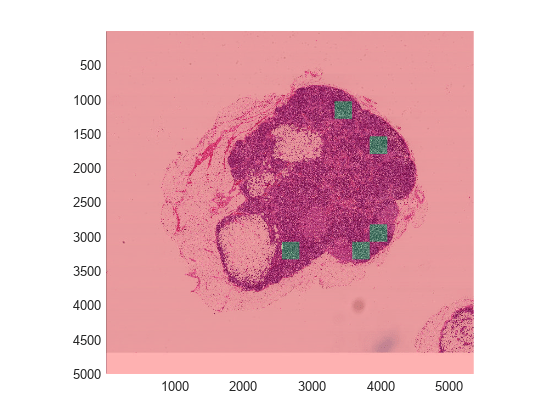
Create a blockedImagedatastore for blocks in which at least 90% of pixels are true in the stained region as defined by the mask.
mbls = selectBlockLocations(bim,Levels=1,BlockSize=[256 256], ...
Masks=bmask,InclusionThreshold=0.90);Create a blockedImageDatastore from this set of blocks.
bimds = blockedImageDatastore(bim,BlockLocationSet=mbls);
Read the blocks from the datastore.
bimds.ReadSize = 10; blocks = read(bimds);
To verify that the datastore reads the correct blocks, display the blocks in a montage.
figure
montage(blocks,BorderSize=5,BackgroundColor="b"); 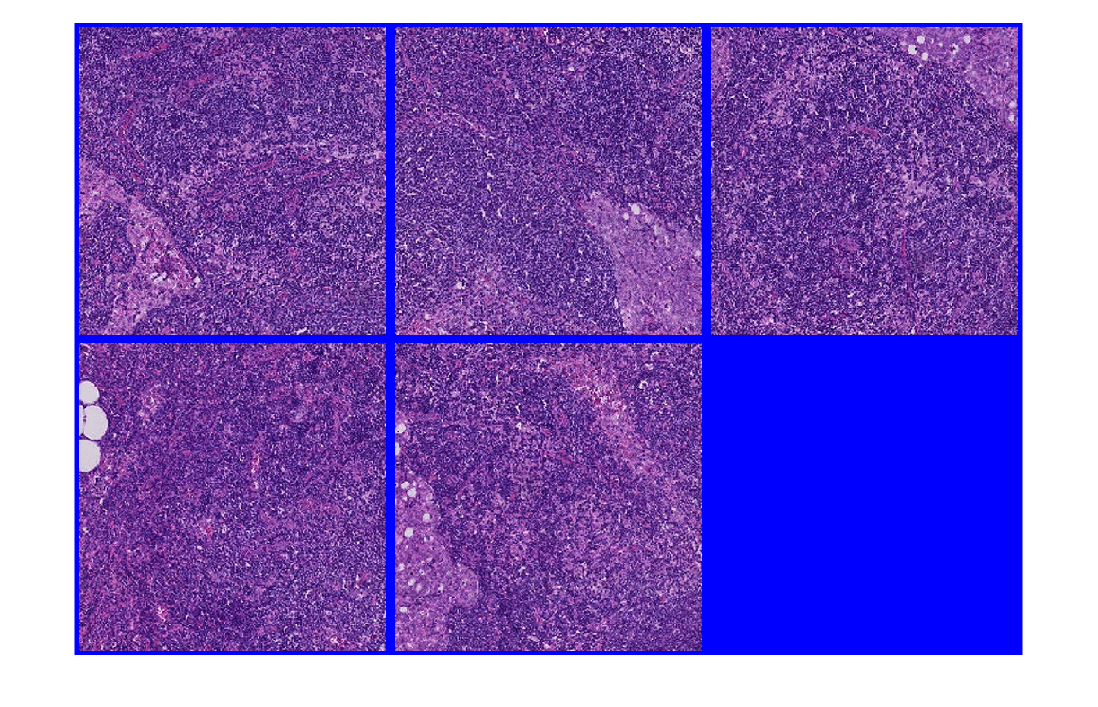
Input Arguments
Blocked images, specified as a blockedImage
object or b-element vector of blockedImage objects.
All blocked images must have the same number of dimensions at the resolution levels from
which blocks are selected.
Name-Value Arguments
Specify optional pairs of arguments as
Name1=Value1,...,NameN=ValueN, where Name is
the argument name and Value is the corresponding value.
Name-value arguments must appear after other arguments, but the order of the
pairs does not matter.
Example: bls = selectBlockLocations(bim,BlockSize=[224 224]) selects
blocks of size 224-by-224 pixels.
Before R2021a, use commas to separate each name and value, and enclose
Name in quotes.
Example: bls = selectBlockLocations(bim,"BlockSize",[224 224]) selects
blocks of size 224-by-224 pixels.
Offset of adjacent blocks, in pixels, specified as a vector of positive integers.
The length of BlockOffsets is less than or equal to the number of
dimensions of the input blocked images. The first two elements specify the offset in
the order (rows, columns).
The default value is equal to BlockSize, which results in
non-overlapping blocks that completely sample the image. To overlap blocks, specify a
smaller value. To add a gap between blocks, specify a larger value. If you specify
block offsets of lower dimensionality than the input blocked image, then the
selectBlockLocations function sets the block offset in the
remaining dimensions equal to the image size in those dimensions.
Example: BlockOffsets=[100 200] specifies a block offset of 100
pixels vertically and 200 pixels horizontally
Block size, in pixels, specified as a vector of positive integers. The length of
BlockSize is less than or equal to the number of dimensions of
the input blocked images.
If you do not specify the BlockSize argument, the default
value is equal to the BlockSize property of the first blocked image
in bims at the finest resolution level. If you specify a block
size of lower dimensionality, then the selectBlockLocations
function sets the block size in the remaining dimensions equal to the image size in
those dimensions.
Example: BlockSize=[1024 512] specifies blocks with a height of
1024 pixels and a width of 512 pixels
Exclude incomplete blocks that are smaller than BlockSize,
specified as a numeric or
logical 0 (false) or 1
(true).
Inclusion threshold for mask blocks, specified as a numeric scalar or a
b-element numeric vector with values in the range [0, 1]. The
InclusionThreshold argument must have the same number of
elements as the Masks argument. The
selectBlockLocations function selects blocks that overlap the
foreground of the corresponding mask block by a percentage greater than or equal to
the value specified by InclusionThreshold.
When the inclusion threshold is
0, theselectBlockLocationsfunction selects a block when at least one pixel in the corresponding mask block is nonzero.When the inclusion threshold is
1, theselectBlockLocationsfunction selects a block only when all pixels in the mask block are nonzero.
Resolution level of blocks from each blocked image in bims,
specified as a positive integer or b-element vector of positive
integers. If you specify a scalar value, the selectBlockLocations
function selects blocks from all blocked images at the same resolution level. The
default value is a b-element vector of 1s, which
selects blocks from the finest resolution level of each image in
bims.
Data Types: double
Mask images, specified as an array the same size as bims. The
underlying data type of the mask images is logical. The
selectBlockLocations function selects blocks that overlap the
foreground of the corresponding mask block by an amount specified by
InclusionThreshold. Masks are expected to be in the same world
coordinate system as the corresponding blockedImage in the
bims array.
Use parallel processing to evaluate mask blocks, specified as a numeric or
logical 0 (false) or 1
(true). Parallel evaluation of masks is beneficial when the masks do not fit in
memory.
Use of parallel processing requires Parallel Computing Toolbox™. The selectBlockLocations function uses an existing
parallel pool of workers, or opens a new pool when no parallel pool is active. The
Source property of each blocked image in
bims must be a valid path on all of the parallel
workers.
Output Arguments
Block locations, returned as a blockLocationSet object.
References
[1] Bejnordi, Babak Ehteshami, Mitko Veta, Paul Johannes van Diest, Bram van Ginneken, Nico Karssemeijer, Geert Litjens, Jeroen A. W. M. van der Laak, et al. “Diagnostic Assessment of Deep Learning Algorithms for Detection of Lymph Node Metastases in Women With Breast Cancer.” JAMA 318, no. 22 (December 12, 2017): 2199–2210. https://doi.org/10.1001/jama.2017.14585.
Version History
Introduced in R2020b
MATLAB Command
You clicked a link that corresponds to this MATLAB command:
Run the command by entering it in the MATLAB Command Window. Web browsers do not support MATLAB commands.
选择网站
选择网站以获取翻译的可用内容,以及查看当地活动和优惠。根据您的位置,我们建议您选择:。
您也可以从以下列表中选择网站:
如何获得最佳网站性能
选择中国网站(中文或英文)以获得最佳网站性能。其他 MathWorks 国家/地区网站并未针对您所在位置的访问进行优化。
美洲
- América Latina (Español)
- Canada (English)
- United States (English)
欧洲
- Belgium (English)
- Denmark (English)
- Deutschland (Deutsch)
- España (Español)
- Finland (English)
- France (Français)
- Ireland (English)
- Italia (Italiano)
- Luxembourg (English)
- Netherlands (English)
- Norway (English)
- Österreich (Deutsch)
- Portugal (English)
- Sweden (English)
- Switzerland
- United Kingdom (English)